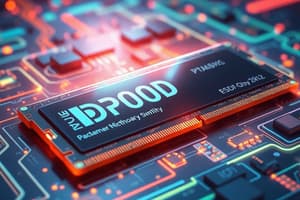Podcast
Questions and Answers
What was the major innovation in first-generation computers?
What was the major innovation in first-generation computers?
Vacuum Tubes
Which computer from the first generation was built in 1946 and used during World War II for military purposes?
Which computer from the first generation was built in 1946 and used during World War II for military purposes?
ENIAC
What was the major innovation in second-generation computers?
What was the major innovation in second-generation computers?
Transistors
What technology was used for data storage in second-generation computers?
What technology was used for data storage in second-generation computers?
Which computer from the first generation was the first general-purpose electronic digital computer designed for commercial use?
Which computer from the first generation was the first general-purpose electronic digital computer designed for commercial use?
What were some disadvantages of the first-generation computers?
What were some disadvantages of the first-generation computers?
Who is considered the father of computing?
Who is considered the father of computing?
What was the purpose of the Difference Engine?
What was the purpose of the Difference Engine?
When was the Analytical Engine built?
When was the Analytical Engine built?
How many additions per minute could the Analytical Engine perform?
How many additions per minute could the Analytical Engine perform?
What are the five units contained in the Analytical Engine?
What are the five units contained in the Analytical Engine?
What type of operations was the mill unit in the Analytical Engine used for?
What type of operations was the mill unit in the Analytical Engine used for?
Study Notes
First-Generation Computers
- Major innovation: Introduction of vacuum tubes for circuitry, replacing mechanical switches.
- ENIAC (Electronic Numerical Integrator and Computer), built in 1946, was utilized during World War II for military calculations.
- UNIVAC I was the first general-purpose electronic digital computer designed for commercial use.
Disadvantages of First-Generation Computers
- Large physical size and high power consumption.
- Generated significant heat, leading to reliability issues.
- Programmed in machine language, making programming complex.
Second-Generation Computers
- Major innovation: Use of transistors, which were smaller, more reliable, and energy-efficient compared to vacuum tubes.
- Magnetic core memory technology was used for data storage, increasing speed and efficiency.
Father of Computing
- Charles Babbage is recognized as the father of computing due to his foundational work in early mechanical computers.
Difference Engine
- Designed to automate polynomial calculations, intended for producing mathematical tables.
Analytical Engine
- Built in the mid-1800s, although it was never completed during Babbage's lifetime.
- Capable of performing 60 additions per minute.
- Composed of five units: the mill (for arithmetic operations), store (memory), control (operator), input, and output.
Operations of the Analytical Engine
- The mill unit was specifically used for performing arithmetic operations, such as addition and multiplication.
Studying That Suits You
Use AI to generate personalized quizzes and flashcards to suit your learning preferences.
Description
Test your knowledge on the definition and characteristics of computers, including memory, speed, automation, accuracy, reliability, versatility, and diligence. Learn about the history of computers from ancient devices like the Abacus to modern machines.




